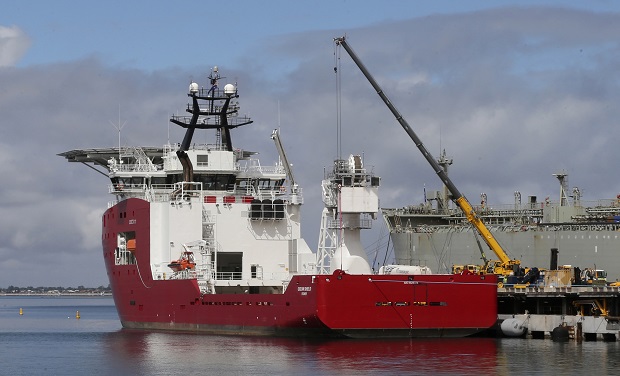Q&A on the MH370 mystery

Australian defense ship Ocean Shield lies docked at naval base HMAS Stirling while being fitted with a towed pinger locator to aid in her roll in the search for missing Malaysia Airlines Flight MH370 in Perth, Australia, Sunday, March 30, 2014. The Australian warship with an aircraft black box detector was set to depart Sunday to join the search. It will still take three to four days for the ship, the Ocean Shield, to reach the search zone — an area roughly the size of Poland about 1,850 kilometers (1,150 miles) to the west of Australia. AP
SYDNEY — Almost three months after flight MH370 went missing, there is still no sign of what happened to the plane which was carrying 239 people on a routine flight from Kuala Lumpur to Beijing.
When ping signals were detected in the Indian Ocean in April, hopes rose that they were emanating from the aircraft’s black box flight recorders, and the search intensified in their vicinity.
Yet a sophisticated mini-sub searching the ocean floor near the sounds has found no sign of the plane and some experts now believe they did not come from the jet.
Here are answers to some key questions:
Q: Are the ‘pings’ from MH370?
Article continues after this advertisementA: It cannot be ruled out, but international consensus is now that the series of acoustic transmissions at the heart of the Indian Ocean search did not come from MH370’s black box, according to a senior US Navy official.
Article continues after this advertisementAustralian search chief Angus Houston had previously described the signals detected using US Navy equipment as “consistent” with those from aircraft black boxes.
But US Navy deputy director of ocean engineering Michael Dean told CNN on Thursday there was now broad agreement that they came from some other man-made source.
The US Navy later downplayed his comments as “speculative and premature”, even though Dean said other countries involved in the Australian-led search had reached the same conclusions.
Q: What happens next?
A: The pings, combined with the failure of a massive aerial and sea surface search to locate any wreckage from the plane, have been at the center of the undersea search.
Scott Hamilton, managing director of US-based aerospace consultancy Leeham Co. said officials would now have to re-evaluate all the data “from start to finish” to see if any of it had been misinterpreted, including the Indian Ocean search arc itself.
Because the plane’s communications systems appear to have been shut down around the time it went missing, officials have been forced to piece together its supposed journey using satellite signals, radar data and aircraft performance calculations.
“Since the Inmarsat (satellite) data sent them to the Australian area, this will come under particular scrutiny,” Hamilton told AFP via email.
“They either validate their original conclusions and figure the ‘recorder pings’ were in error but the satellite data was valid; or they decide the Inmarsat analysis was incorrect.”
Terence Fan, an aviation expert at Singapore Management University, said the discounting of the pings alone was unlikely to change the course of the search, which is expected to move into an intensified underwater hunt in the same region.
“It’s not official, and I don’t think there is anything conclusive,” he told AFP of the latest revelation. “Everything is up in the air now… But that’s the best thing we have.”

Australia’s Transport Minister Warren Truss, second from left, Malaysia’s acting Transport Minister Hishammuddin Hussein, left, and China’s Transport Minister Yang Chuantang, second from right, attend a press conference for the nearly two-month-old hunt for the missing Malaysian jet with search coordinator Angus Houston, center, in Canberra, Australia, Monday, May 5, 2014. Senior officials from Malaysia, Australia and China are meeting in the Australian capital to hash out the details of the next steps in the search for Malaysia Airlines Flight 370, which will center around an expanded patch of seafloor in a remote area of the Indian Ocean off Western Australia. AP
Q: Should the search be called off?
A: Experts believe it is crucial the wreckage is recovered to determine whether mechanical failure is behind the mystery to prevent future accidents.
Hamilton said while the new development could alter the course of the sea search, pending a reevaluation of data, it would probably not end the search itself.
“If you mean do they stop looking for the airplane entirely and just write it off as missing forever, I would say, ‘Not yet’,” he said.
“They need to exhaust all analysis. Remember, it took two years to find (Air France flight) AF447, and they had a general idea where to start looking. I think it will be some time, perhaps years, before they completely throw in the towel.”
Q: If the pings are not from MH370, might the plane never be found?
Even if the pings are confirmed not to be from MH370, the Air France example shows that success is still possible.
Its black boxes were not located before their signals expired, necessitating a two-year search using submersible drones and other means to locate a debris field.
But authorities had a better idea where the Air France crash occurred than what happened to MH370.
Hamilton said based on the information currently available, finding the plane seemed unlikely.
“They need some breakthrough of some kind,” he said.
Q: Was the plane commandeered by hijackers or terrorists?
A: This theory gained early attention due to the revelation that two Iranian passengers boarded using stolen passports, and after Malaysian authorities said the plane appeared to have been deliberately diverted.
But Interpol said the Iranians were apparently just illegal immigrants heading to Europe, and Malaysian police have said investigations had “cleared” all of the plane’s 227 passengers.
Q: Did one or both of the pilots go ‘rogue’?
A: Malaysian authorities have said a knowledgeable flyer likely diverted the plane and that its communications systems appear to have been shut off around the time MH370 went missing, suggesting deliberate action in the cockpit.
All of this has led to intense scrutiny of Captain Zaharie Ahmad Shah, 53, and First Officer Fariq Abdul Hamid, 27, but no evidence has yet emerged to suggest either held extremist views, had psychological problems or any other motive.
Q: Did MH370 become a ‘ghost plane’?
A: This idea gained traction after Malaysia revealed that the plane apparently flew for nearly seven hours after vanishing from radar.
“Ghost planes” — in which the crew is incapacitated, leaving the plane to fly on aimlessly — have occurred before. In 2005, a Greek Helios Airways plane with 121 aboard flew for hours after a sudden lack of oxygen incapacitated the cockpit crew. It crashed, killing all aboard.
Some believe MH370’s pilots diverted the plane due to such an event — possibly attempting to return to Kuala Lumpur airport — but were subsequently incapacitated, leaving the plane to fly on autopilot.
The shutting off of communications systems may have been an attempt to stem a fire caused by faulty electrical circuits.
Aviation expert Ron Bishop, from the University of Central Queensland, said the fact that no debris was found suggested the plane did fly for a long time and eventually ran out of fuel.
“If it glided into the water at a good altitude and a decent airspeed, there might not have been a fireball, it might not have broken up because that plane is designed not to break up,” he said.

Relatives of Chinese passengers onboard the missing Malaysia Airlines MH370 plane listens, as part of the audio communications between flight 370’s cockpit and air traffic controllers is played, during a meeting with Malaysian officials at a hotel in Beijing, China, Wednesday, April 30, 2014. AP
Q: Do we know everything the authorities know?
A: Families of passengers aboard MH370 have accused Malaysia of withholding crucial satellite data, saying this week that long-awaited report is incomplete and does not prove the plane crashed in the Indian Ocean.
Authorities on Tuesday released a 47-page summary of communication logs from the Malaysia Airlines plane recorded by British satellite operator Inmarsat but critics said the government failed to provide crucial supporting details.
Malaysia has insisted it is doing as much as it possibly can in an unprecedented situation.
But the perceived lack of transparency has helped sustain conspiracy theorists who allege that the truth is being hidden or manipulated by Malaysia’s authoritarian government.
Q: What aviation changes might arise from MH370?
A: The aviation industry has a history of learning from disasters and implementing safeguards, making air travel one of the world’s safest modes of transport.
MH370 has already sparked new discussion of implementing real-time satellite tracking of airliners to stop them going missing, and possibly reassessing the pilot’s ability to turn off communications systems.
RELATED STORIES
MH370 remains a mystery as Malaysia releases report